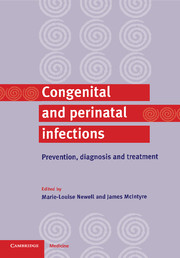Book contents
2 - Pregnancy, immunity and infection
Published online by Cambridge University Press: 06 July 2010
Summary
BB: There is at bottom only one genuinely scientific treatment for all diseases, and that is to stimulate the phagocytes.
Stimulate the phagocytes. Drugs are a delusion.
The Doctor's Dilemma, Act I George Bernard Shaw, 1906Introduction
Infection, particularly puerperal infection, has been a persistent threat to successful reproduction, and generations of women have lost their lives during and after childbirth as a result of infectious disease. Major epidemics of puerperal sepsis, such as that described by Peu in Paris in 1664, and that which occurred in Lombardy in 1772, left few if any survivors (Graham, 1950), and the vectors of infection were the doctors more often than not. The work of Holmes in 1843 and of Semmelweiss in 1861 led to the recognition of infection as the cause of ‘childbed fever’, and eventually resulted in a reduction in the role of the obstetrician as the bearer of the causative microorganisms. For this and other reasons, sepsis is no longer an epidemic killer of puerperal women.
Survival in a world surrounded by hostile and potentially harmful organisms depends upon the development of defence mechanisms. Clearly, the first line of defence will be an intact skin, and the employment of physical and chemical measures to enhance its impenetrability.
However, existence also requires that there be interaction with the surrounding environment. The assimilation of nutrients and oxygen dictates that the external defence be breached and, inevitably, microorganisms will accompany whatever is absorbed. When microorganisms have entered the body, defence depends upon the development of an immune response.
- Type
- Chapter
- Information
- Congenital and Perinatal InfectionsPrevention, Diagnosis and Treatment, pp. 15 - 31Publisher: Cambridge University PressPrint publication year: 2000



